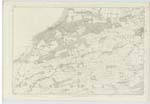OS1/3/39/5
| List of names as written | Various modes of spelling | Authorities for spelling | Situation | Description remarks |
|---|---|---|---|---|
| CULZEAN COVES | Culzean Coves Culzean Coves Culzean Coves Coves |
Alexander McCaw J Findlay Thomas Oliver Johnston's County Map |
044 | Rendered classical by the strains of Burns in his poem on Hallow E"en are three in number and are formed in the rock on which Culzean Castle stands. The most-Western cove has its entrance 20 feet above the base of the cliff and consists of two openings connected by a small door way built of stone & lime, each of these openings are 55 feet in length by 30 feet in breadth. The roof of the inner recess is 20 feet high & slopes [gradually] towards the sides and furthest extremity where it- joins the floor. The roof of the outer opening is 30 feet high, A narrow passage 30 feet in length leads from this recess into another huge cove 110 feet-long and 13 feet broad the roof is 30 feet high and has a very irregular appearance. The mouth of this cove which has been very large and nearly level with the water mark, is built-up with a stone & lime wall & formed with several small windows, A small stone couch extends from this wall 8 feet inwards and is built over a spring of good water. Tradition reports these coves to have been the hiding place of Sir Archibald Kennedy of Culzean, (a persecutor of the Covenanters) after the Reformation. Towards the East is the largest Cove which has two entrances, (as low as high water mark) forming as acute angles. it extends inwards 220 feet- and varies from 30 to 15 feet in breadth. the greatest height - of the roof is 40 feet, above the angle of the [entrance] it then lessens gradually towards the furthest extremity where it joins the floor. |
Continued entries/extra info
Sheet 44.2 -- Parish of Kirkoswald -- [Page] 5[Note] "The Coves of Culzean, referred to by
Abercrummie, have long been famed in fairy
tradition, and are considered curious as
objects of nature. The outer cove, which enters
at low water mark, is about fifty feet high in the
roof, and nearly two hundred feet long, extending
inwards. The other two are considerably less,
but of the same irregular form. There are other
three coves, towards the east, which also communicate
with each other. They are nearly
of the same height and form as the other.
It is popularly believed that these coves extend
an unknown distance into the interior;
and in corroboration of this, it is said that a
piper, who had lost his way amongst them,
was heard playing several miles from the sea!
" Patterson's History of Ayrshire (1847)
Transcribers who have contributed to this page.
Chr1smac -Moderator, NRS - Moderator, Jeni
Location information for this page.
Linked mapsheets.




